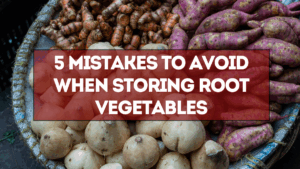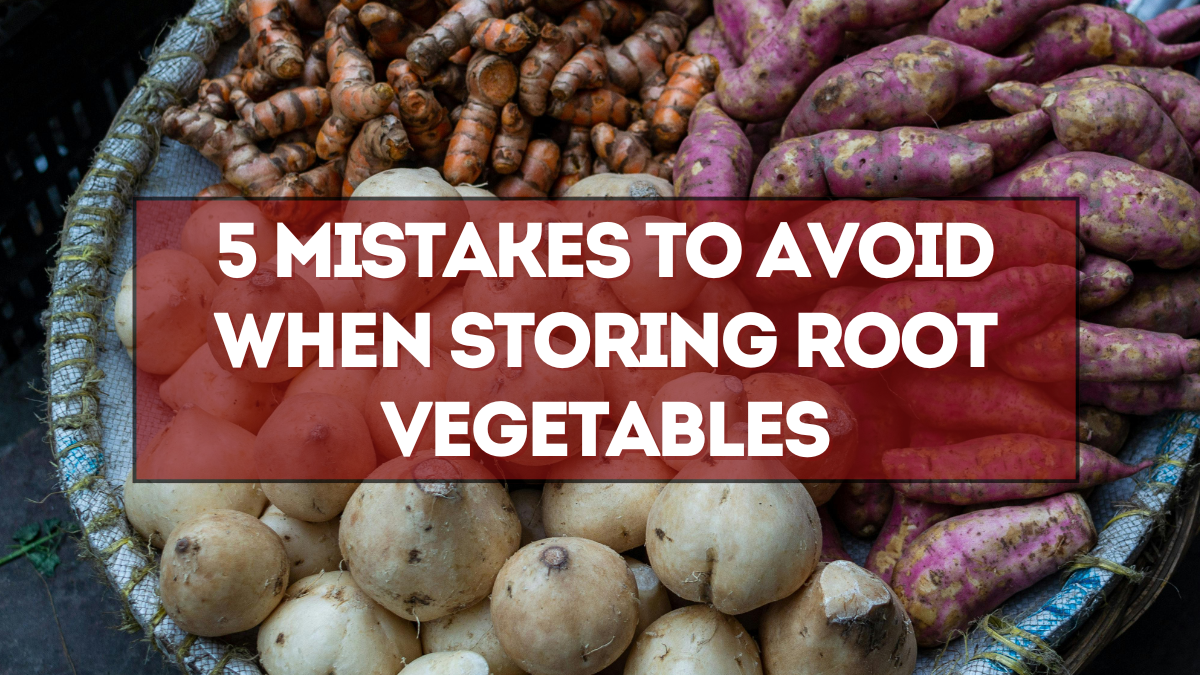Root vegetables like potatoes, carrots, beets, turnips, and parsnips are staples in many households. They are nutritious, versatile, and can last for months if stored correctly. However, many gardeners and home cooks unknowingly make mistakes when storing root vegetables that cause them to sprout early, rot, or lose flavor quickly. Proper storage is not just about tossing them in a basket—it involves controlling temperature, humidity, curing, and airflow to extend their shelf life.
In this guide, we’ll explore the five most common mistakes people make when storing root vegetables and provide simple, effective fixes to ensure your harvest lasts as long as possible.

Why Root Vegetables Need Special Storage
Unlike leafy greens or fruits, root vegetables are underground storage organs that hold energy in the form of starches and sugars. This makes them durable but also sensitive to certain conditions. Too much moisture, exposure to light, or poor airflow can trigger sprouting, mold, or decay. Understanding these sensitivities is the first step to avoiding costly mistakes.
Mistake 1: Skipping the Curing Process
One of the biggest mistakes is skipping the curing stage after harvest. Root vegetables like potatoes, carrots, and beets need time to toughen their skins before being stored. If stored immediately, small cuts and bruises from harvest can allow moisture loss and pathogens to enter.
Fix:
-
Cure potatoes and sweet potatoes by laying them in a dark, well-ventilated space at 55–65°F (12–18°C) for 1–2 weeks.
-
Carrots, beets, and turnips need less curing—just a few days in a shaded, cool spot.
-
After curing, gently brush off excess soil but avoid washing, as moisture speeds up spoilage.
This step extends storage life by weeks or even months.
Mistake 2: Storing at the Wrong Temperature
Temperature is critical. Many people keep root vegetables in places that are too warm, like kitchens or pantries, which speeds up sprouting and shriveling. Others make the mistake of refrigerating potatoes, which causes starches to convert into sugars, altering taste and texture.
Fix:
-
Store potatoes at 45–50°F (7–10°C) in a cool basement, cellar, or insulated garage.
-
Carrots, beets, parsnips, and turnips prefer colder conditions—32–40°F (0–4°C). A refrigerator crisper drawer works well for these.
-
Sweet potatoes need warmer storage, around 55–60°F (13–16°C).
Matching each vegetable to its ideal temperature helps retain flavor and firmness.
Mistake 3: Ignoring Humidity Levels
Too little humidity causes root vegetables to shrivel, while too much leads to rot. Many people store them in dry cupboards or overly damp basements, both of which shorten storage life.
Fix:
-
Root crops like carrots and beets need 90–95% humidity. Store them in perforated plastic bags in the refrigerator or in damp sand in a cellar.
-
Potatoes prefer 80–90% humidity. Paper bags, burlap sacks, or ventilated bins work best.
-
Never seal root vegetables in airtight containers, as this traps moisture and accelerates decay.
Controlling humidity is one of the most effective ways to keep vegetables crisp.
Mistake 4: Poor Airflow and Ventilation
Another common mistake is stuffing root vegetables into sealed containers or plastic bags without ventilation. Lack of airflow leads to condensation, mold, and fungal growth.
Fix:
-
Use ventilated wooden crates, mesh bags, or burlap sacks.
-
For long-term storage, layer crops in boxes filled with damp sand, sawdust, or peat moss to regulate moisture while still allowing airflow.
-
Avoid stacking vegetables too tightly—crowding encourages rot to spread quickly if one piece spoils.
Think of airflow as the invisible factor that keeps stored vegetables fresh.
Mistake 5: Mixing Incompatible Vegetables and Fruits
Not all produce gets along in storage. A common mistake is storing root vegetables next to fruits that release ethylene gas, like apples, bananas, or tomatoes. Ethylene triggers sprouting and accelerates spoilage in potatoes, carrots, and beets.
Fix:
-
Store root vegetables separately from ethylene-producing fruits.
-
Keep potatoes away from onions; although often stored together, onions cause potatoes to sprout faster.
-
Create dedicated zones or bins for each crop in your cellar or pantry.
Separation is key to preventing chemical interactions that shorten storage life.
Additional Tips for Long-Term Root Vegetable Storage
-
Check regularly: Inspect stored vegetables every few weeks and remove any that show signs of sprouting or rot. One bad potato can spoil the batch.
-
Store unwashed: Washing introduces moisture and encourages mold. Brush off soil instead.
-
Use the right containers: Dark, breathable bags or crates are better than clear plastic boxes.
-
Keep in the dark: Light exposure causes greening in potatoes and changes in flavor for other root crops.
These small practices can extend your harvest’s freshness for months.
Why These Fixes Work
Each of these corrections targets a biological factor affecting root vegetables:
-
Curing toughens skins and heals small wounds.
-
Temperature control slows metabolic processes and sprouting.
-
Humidity regulation prevents drying or rotting.
-
Airflow discourages fungal growth.
-
Separation eliminates ethylene gas contamination.
When combined, these fixes create the ideal environment for long-term storage.
FAQs
Do I need to wash root vegetables before storing them?
No. Store them unwashed, simply brushing off excess soil. Washing adds moisture that accelerates spoilage.
Can I store potatoes in the refrigerator?
No. Cold temperatures below 45°F turn potato starch into sugar, giving them a sweet taste and odd texture.
How do I keep carrots crisp for months?
Store them in a perforated bag in the refrigerator or pack them in damp sand inside a cellar. High humidity is essential.
Why do my potatoes sprout so quickly?
They are likely stored in a warm or bright area, or near ethylene-producing fruits. Keep them cool, dark, and separate.
Which root vegetables last the longest?
Potatoes, carrots, and beets can last 3–6 months if cured and stored properly, while parsnips and turnips generally last 1–3 months.
Click here to know more.
